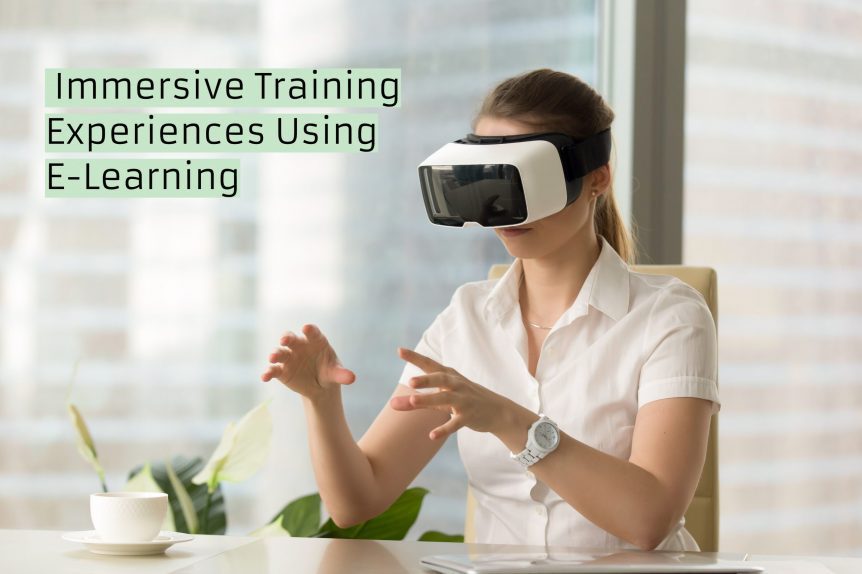12 Ways to Create Immersive Training Experiences Using E-Learning
In a previous blog, we looked at the concept of immersive learning, the problems it addresses, and the benefits of creating e-learning modules that are immersive.
What features and elements differentiate a standard e-learning module and one that is immersive? How do you create immersive training experiences using e-learning? Here are our 12 tips.
1. Base Content Elements in Real-Life
Make sure you include content elements that are realistic. This includes scenarios, videos, animations, etc. Learners are more likely to engage with the course if they are familiar with the situations and people being presented.
2. Use Scenarios
Scenarios were mentioned above. They are central to creating e-learning content that delivers an immersive learning experience.
Scenarios are a digital form of role-playing, where you present a situation and get learners to make decisions. Each decision leads to another until the scenario comes to a conclusion.
You can use scenarios as a learning tool to show learners what they did right and what they did wrong. They are also helpful for assessing how well learners have understood the concepts and ideas you are teaching them.
3. Establish a Connection with the Learner
Relate the content, elements, and features of the e-learning course to the everyday experience of learners.
It’s also important to put the learner at the centre of the content wherever possible. In a scenario, for example, make the learner the central character rather than creating a fictional character. When the learner then makes decisions within the scenario, they will do so on their behalf rather than on behalf of a fictional character.
4. Provide Breakout Content
This could be additional, optional sections of the course or a separate course on a different but related topic. It could also be links to other materials, i.e. websites, reports, blogs, articles, etc.
Breakout content allows learners to go into the topic in more depth if they choose. It also gives learners who may not be familiar with a topic, or feel they need to top up their knowledge, access to the content they need.
5. Recreate Real-Life Situations or Environments
This includes recreating as much as possible the stresses, pressures, and challenges of real-life situations. An irate customer, for example, or being put under pressure to complete a task.
There are lots of ways to achieve this. In a scenario, for example, you can put time limits on how long the learner has until they need to take action or make a decision.
6. Give Learners a Greater Sense of Ownership Over How They Learn
This can include letting learners decide when and where they complete the training module.
When completing the module at a time of their choosing, they are more likely to become engaged with the content than if you force them to do it at a specific time. In the latter situation, the risk is learners might simply get through it as quickly and easily as possible.
7. Make the Training Social
Add social learning features to your e-learning modules where learners chat, communicate, and support each other. Social features also make it easier for learners to communicate with trainers, ask questions, and find out more information.
8. Add Gamification Elements
Gamification elements can be features that have the look, feel, and interactivity of playing a game.
There are other ways of adding gamification elements to your e-learning courses, however. This includes awarding points to learners, letting them earn badges, and creating levels for the learner to achieve.
These elements give learners something to strive for, plus they are familiar with badges, points, and levels in other games they play and apps they use. Therefore, this sort of content makes the training more immersive.
9. Use Visual Content
Make the content in your e-learning courses as visual as possible. Here are some examples of elements to include, often as a replacement for text:
- An attractive, modern, and professional design
- Media elements including images and videos
- Infographics and interactive visual elements
10. Create Collaborative Learning Experiences
Your team will become more engaged in your e-learning modules if there are collaborative elements. This is often referred to as social learning, and typically involves learners working together to complete certain tasks.
11. Use AR or VR Technologies
Augmented reality (AR) and virtual reality (VR) technologies represent a high-point of immersive e-learning experiences.
With these technologies, learners can see and hear the situation you present them with, making it more realistic. There are challenges to overcome, of course, not least in the fact that AR and VR training experiences often require a headset.
In the right circumstances, however, these technologies can be very powerful.
12. Ensure You Focus the Content on Your Training Objectives
With all the above, there is a risk you will begin adding features for the sake of the feature or content for the sake of the content. In other words, where you include content or features in an attempt to make the training more immersive but that don’t help achieve your goals or objectives.
This will have the opposite effect of making the training immersive. Instead, it will clutter the course and the content will be distracting. It will also take learners longer than necessary to complete the course.
So, make sure everything you add to the course helps you achieve your training goals.
Where to Start
You don’t need to follow all the above tips to create an immersive e-learning experience, and it’s always important to be aware of the last point. Selecting the tips, elements, and features that best suit your training topic, learners, and objectives is the best approach.
It is also helpful to hire a professional e-learning developer with experience creating immersive e-learning modules for learners and employees in Saudi Arabia and the UAE. This will ensure you get the highest possible standard and the best possible result.
